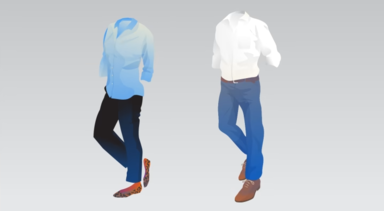Breadcrumb
Dress for Success
Make a great first impression with the clothes that you wear. Look and feel your absolute best at your interview!
Some industries allow a more relaxed form of interview attire, while others are more formal. It is your responsibility to know the industry and dress accordingly. If in doubt, check with the employer, do some on-line research, or contact someone you know who works for this organization. It is certainly better to error on the side of being more formal than being too casual.
Professional Dress
Professional dress clothes are well pressed, clean suits without dangling threads. Buying a suit for the first time? Carefully inspect clothes for tags and make sure to cut the threads to open the slits on suit coats and suit skirts.
Suits:
A conservative well-pressed (black, navy, gray, brown) pant or skirt suit is best. Make sure the suit is not too tight to sit down comfortably and not too loose either. If you want to express yourself, simply add a colored shirt under the jacket, but avoid bright colored suits. If you are wearing a tie, go for a solid color or a simple pattern. Trendy doesn’t always equal appropriate for the traditional interview!
Shirt:
Select a top that is neat, pressed, and clean, such as traditional button-down or a simple round neckline. Avoid shirts that can be interpreted as revealing. Remember, business professional dress tends to be more conservative.
Shoes:
Overly flashy or casual shoes draw attention away from your face and thus your interview answers! Select solid colored, closed-toed shoes that are clean and shined…in which you can comfortably walk!
Accessories/Grooming:
Coordinate your socks/hosiery with your outfit and shoes. Always avoid socks that are white, have a bold pattern, or look athletic with your suit. Belts should also match your suit or shoes. Keep your hair neat, including facial hair. Nails should also be clean and short. Avoid strong fragrances. Keep accessories and make-up simple and coordinated with your outfit. You are welcome to bring a padfolio to contain your notes and any extra professional documents, such as a resume, cover letter, or reference page.
Business Casual Dress
Business casual is crisp, neat, and should look appropriate even for a chance meeting with a CEO. Avoid tight or baggy clothing, but you do have more opportunity to mix and match your clothing. A tie is an option, but not required, and avoid clothes that reveal too much skin.
Shirts:
Choose collared shirts, blouses, sweaters, or blazers. Use a collar for a more formal look and collarless for a less formal look. Make sure to tuck in the shirt when appropriate and pair with a belt. Pressed polo shirts are a great choice if you know the environment will be quite casual, outdoors, or in a very hot location.
Pants/Skirts:
Neatly pressed khaki or solid colored pants and skirts in neutral tones are a safe choice. Pants should extend to the top of your shoe or slightly longer and skirts should fall at or below the knee. Sundresses and jeans are too casual.
Accessories:
Wear a leather belt and leather shoes when wearing pants. Make sure the belt color matches your shoe color. Oxfords, loafers, flat slip-ons, and high heels are okay. Athletic shoes, sandals, and flip-flops are not considered business casual. If you choose to wear jewelry or make-up, simple and understated is best and try to coordinate any bags or brief cases with your outfit.



Building Your Work Wardrobe on a Limited Budget
- Purchase clothing that can be used in many settings
- Neutral pieces are practical since they can go from professional to business casual.
- Neutral pieces can also be paired with a suit jacket or a variety of different dress shirts, skirts, or ties.
- Consider investing in cotton-blends because they drape and travel well. Wool and linen are not as versatile with the changing weather.
- 3 piece suits are available so you can alternate between a skirt and pants suit when desired.
- Avoid spending a lot by shopping at the last minute, because you “need something now”.
- Shop out of season and search for sales in order to avoid paying full retail price.
- Do clothing exchanges with friends to trade lightly used pieces, and do not hesitate to check out thrift shops.
- Also - some local consignment shops have sections just for business clothes with matching accessories.There are several quality consignment shops in the Iowa City area.
- Take care of your clothes—when machine washable, use the gentle cycle on cold and make sure to zip up zippers in order to make them last longer, make the small hemming and button repairs when needed, fold and store clothes properly, and put leather protector on your shoes.
If you are in need of free professional attire, please visit the Clothing Closet at Iowa.